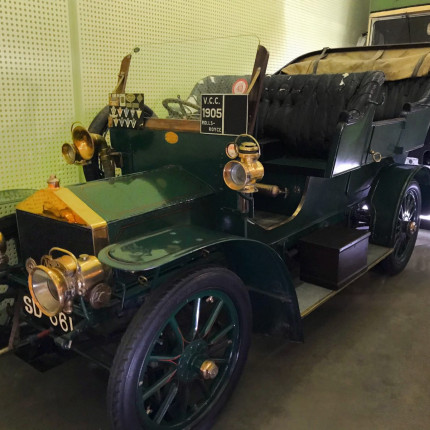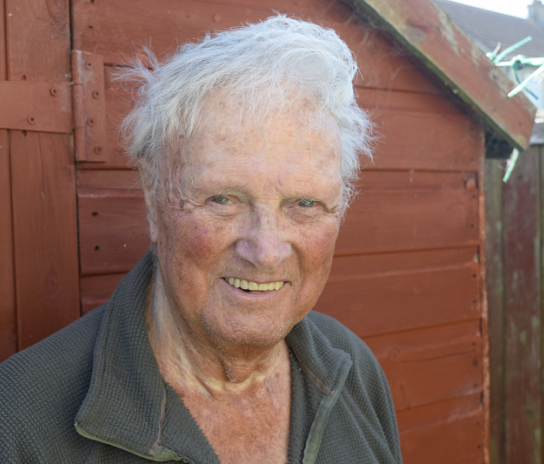Sitting proud and prominent, the Rolls-Royce motorcar at Glasgow’s Riverside Museum is admired by hundreds of people every day. Most visitors to the museum can only imagine it rolling down cobbled streets.
But army veteran John Cassidy, who has cataracts and macular degeneration, remembers many a trip in the vintage motorcar.
John maintained the green Rolls-Royce over several decades when it was owned by Adam McGregor Dick, the owner of the Dick Brothers garage in Kilmarnock. The Rolls-Royce was built 118 years ago in 1905. It is the second-oldest Rolls-Royce in the world.
John, who is now aged 92 and lives in Kilmarnock, said he started working at Dick Brothers garage in Kilmarnock in 1944 when he was just 14 years old.
John said: “When I was a boy, there weren’t many cars about. It was horses and carts. I worked in the Dick Brothers shop, then started my apprenticeship when I turned 16.
“Adam Dick was a middle-aged man at that time, but he and I struck up a good friendship. I don’t know why, but he took me under his wing.”
John worked as a mechanic for 32 years— and the Rolls-Royce was his special charge.
“We got the Rolls-Royce in good shape. It had a three-cylinder engine. Adam used to call it his ‘Old Girl’.
“Whenever there was something wrong with the Rolls, I was down there repairing it. We made a new cylinder for the engine and repaired all its different parts,” he said.

“With my eyesight, I’ve got to be very careful. I’ve got to use a walking stick, which I put in front of me to make sure I won’t walk into anything.”
Several years later, the dedicated mechanic would be lent the Rolls Royce to go on trips with his wife and sons. Ian Cassidy, John’s son, remembers the Rolls fondly.
Ian said: “I remember being in the Rolls when I was 10 years old, in 1966. Everywhere we went, everyone who saw this Rolls just stopped and stared.
“One time, my dad drove the Rolls from Kilmarnock to St Andrews. I remember going down the old A77. We were going down a hill, and suddenly the solid rubber tyre came off! We saw it roll past us down the hill, overtaking us!
“My Dad recognised it and pulled over. He retrieved it, and changed the wheel with a spare wheel, and got us up and on to St Andrews. Back then, St Andrews Golf Club was a place where common folk didn’t get into, but Adam got us in.”
John used his mechanical nous during his National Service with the British Army. He served in Egypt from 1951 to 1953. At the time, the British Army watched over the Suez Canal, which connects the Mediterranean Sea to the Indian Ocean.
John said: “I was assigned to the Royal Artillery. All of us soldiers were patrolling and defending the ammunition dumps. We camped in tents, with six soldiers to a tent. I met an awful lot of good fellas: English, Welsh, guys from Glasgow, you name it.
“The army knew I was a motor mechanic, so I worked on repairing the vehicles. The captain liked motorbikes and so he secured motorbikes for me and him. I got them shipshape, and then we’d go out into the desert.”

John recalls many odd sights in the Egyptian desert, where his regiment would camp out for military exercises.
“One time, one of my pals came over…and says, ‘John, come and see this’.
"We walked over a sand dune and suddenly, there was a field of melons. A football field-sized valley enclosed by bamboo, full of watermelons – and nobody around. Unbelievable.
“The captain said, ‘Don’t touch anything’. We were told the Bedouins depended on the melons for their livelihood, and they defended them. No one went near them. The following morning, we moved on."
Another time, the sergeant was fishing in a lake near the Suez Canal.
John said: “He pulled in this enormous fish, an absolute monster. You have no idea the size of this fish. It was as tall as he was and fearsome looking. We had been swimming in the lake before that, but we never went back in after seeing that monster. There were a lot of good times, looking back at them.”
John returned to Kilmarnock when his service concluded and raised two sons with this wife. These days, John enjoys listening to the Beatles, Elton John and Elvis on his records and CDs.
John said: “With my eyesight, I’ve got to be very careful. I’ve got to use a walking stick, which I put in front of me to make sure I won’t walk into anything.”
Many years earlier, John had asked Adam what he planned to do with his Rolls-Royce.
“Adam asked me, ‘What would you do with it if I gave it to you?’ I said I’d sell it, no question.
“Adam said, ‘I know, that’s why I won’t leave it to you. I’ll give it to the Royal Automobile Club and they won’t sell it and it won’t leave Scotland. It’ll stay at a museum’.”
And so, the 1905 Rolls-Royce – the second-oldest ever built – remains at the Riverside Museum on the shore of the Clyde, near Partick in Glasgow, and can be visited today.
You may also be interested in
The Hawkhead Centre
The Hawkhead Centre is Sight Scotland Veterans' Paisley-based activity hub for veterans with sight loss.
Types of mobility canes for vision impairment
Mobility canes are a form of mobility aid that enable blind or visually impaired people to go about their daily business when out and about, especially in unfamiliar areas.
